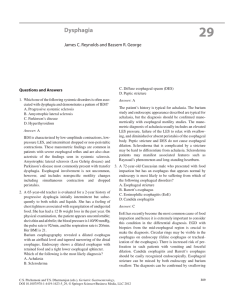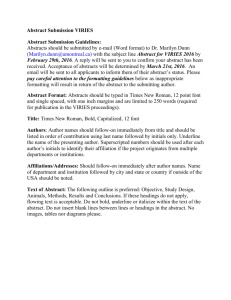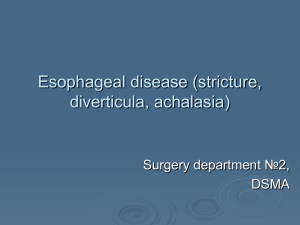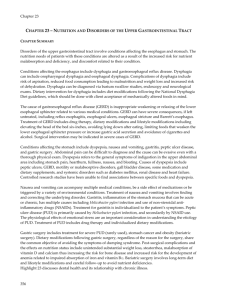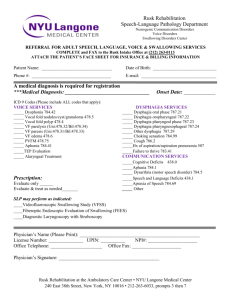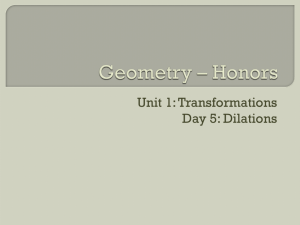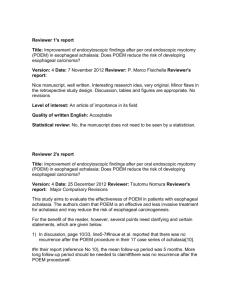Cases in Therapeutic Endoscopy Dr Vikrant Sibartie Consultant Internal Medicine and Gastroenterology
advertisement
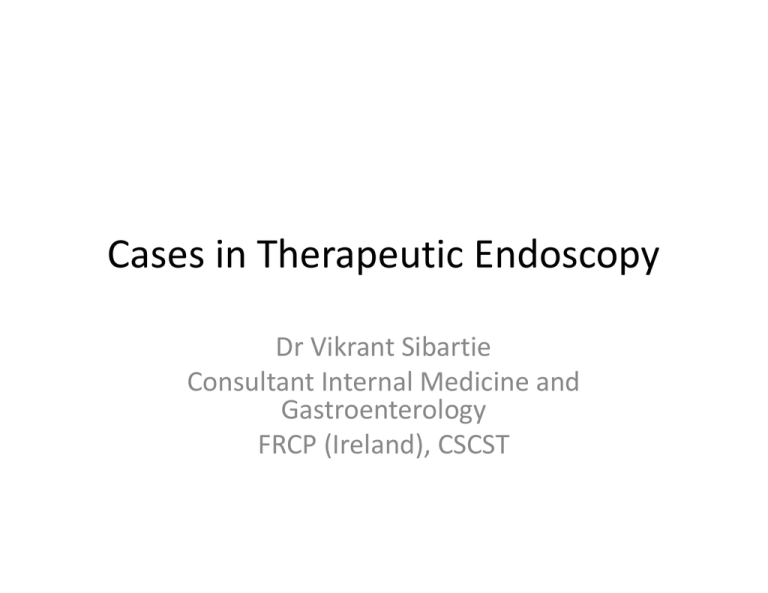
Cases in Therapeutic Endoscopy Dr Vikrant Sibartie Consultant Internal Medicine and Gastroenterology FRCP (Ireland), CSCST CASE 1 • 26 year old female • Seen in OPD in 2011 with few non‐specific symptoms: • ‐Mild leg swelling (non‐pitting) • ‐Progressive weight gain of 25 kg in 5 years ‘since she got married’ • Now 75 kg • ‐obesity in family • At end of consultation, then mentions ‘Also, I have difficulty swallowing solids for the past 2 years’ • OGD advised • Patient never turns up for this Re‐appears in my OPD 1 year later (Oct 2012) Dysphagia has worsened Both solids and liquids Has to mince her food and eat in small portions at a time • Feeling food stuck in lower oesophagus • Chest pains • • • • OGD • Slight pressure at GO junction to pass scope though • No stenosis • Normal OGD • Oesophageal biopsies: Normal mucosa Endoscopic dilatation • Achalasia balloon inflated to 30 mm under 2 Atm pressure at GO junction under endoscopic vision • Able to swallow normally at 1 month follow‐ up What is Achalasia? • • • • ‘Lack of relaxation’ in Greek Aperistalsis of the esophageal body Hypertonic lower esophageal sphincter It is due to a degenerative condition of the neurons of the esophageal wall What is achalasia? • Aperistalsis of the esophageal body • Hypertonic lower esophageal sphincter • It is due to a degenerative condition of the neurons of the esophageal wall Clinical Manifestations TREATMENT OPTIONS BOTOX • Botulinum neuortoxin type A • Inhibits the release of acetylcholine • The idea for the use of BOTOX came from an understanding of the pathophysiology of achlasia • By blocking the release of Ach from the presynaptic channels in the ganglia of Auerbach’s plexus, the theory is that the balance of neurotransmitters is restored BOTOX • Injection is done in the area of the lower esophageal sphincter (LES) • It is administered endoscopically • The standard technique is to inject 1 mL (20 to 25 units BT/mL) into each of four quadrants approximately 1 cm above the Z‐line. • Complications include: – Mediastinitis – Esophageal mucosal ulceration – Pneumothorax BOTOX • BOTOX has the downside of not being as effective as other interventions • While studies have reported symptomatic relief as high as 90% after a few months, the effects generally fall to 50% or lower at one year and continue to diminish after that Pneumatic dilation • Considered the most effective nonsurgical treatment of achalasia • Involves passing the pneumatic device to the LES, using both endoscopy and fluoroscopy to properly place the balloon • The balloon is inflated to a pressure between 7 to 15 psi • Patients are usually observed for six hours and then discharged home Pneumatic dilation • Endoscopic and surgical treatments for achalasia: a systematic review and meta‐analysis – Article from UCSF by Campos et al who reported an initial improvement of symptoms in 84.8% of patients after dilation. • At 36 months this number had decreased to 58.4%. • As with BOTOX, subsequent interventions will have diminishing success rates Surgical Myotomy • Surgical myotomy via the modified Heller approach results in good to excellent relief of symptoms in 70 to 90 percent of patients with few serious complications. • The surgeon weakens the LES by cutting its muscle fibers. • The mortality rate (approximately 0.3 percent) is similar to that reported for pneumatic dilation. CASE 2 Case 2 • 6 year‐old boy • Accidental ingestion of caustic soda at school in 2010 • Progressive dysphagia persisting at 2 months post ingestion Barium swallow OGD • 1st stricture at 15 cm‐unable to pass scope through • Dilated to 10 mm with pneumatic through‐ the‐scope balloon • 2nd stricture at 18 cm‐ Dilated • 3rd stricture more distally, only seen from a distance as unable to pass scope through 2nd stricture completely • Dilation performed under fluoroscopy to 9 mm • Gastrostomy feeding tube inserted by Dr K Teerovengadum (laparotomy) • Dilated with Savary‐Gillard tubes at Victoria hospital (Dr Teerovengadum) • Recurrent dysphagia from re‐stenosis • Oesophageal reconstructive surgery performed at Apollo Bramwell 6 months later • Able to swallow post‐op, but……….. • ………dysphagia recurs 3 weeks later, becomes progressive again OGD‐ Anastomotic stricture at 18 cm • Pneumatic balloon dilation to 15 mm • Scope passes through to stomach and duodenum 1 month later • Dysphagia recurs • Stricture dilated with Savary‐Gillard dilators at VH (Dr Teerovengadum) • Results short‐lived, only able to swallow liquids after 2 weeks • Endoscopic balloon dilation to 15 mm 3 months later • Dysphagia to liquids recurs • Thoracotomy with stricture resection and end‐ to‐end anastomosis performed at ABH (Dr Teerovengadum) ……….3 months later • • • • Dysphagia recurs Developed anastomotic stricture again Balloon dilation to 20 mm Triamcinolone 80 mg injected in 4 quadrants 1 month later • Dysphagia recurs • Stricture dilated, with Triamcinolone injection …..1 month later • Dysphagia recurs • Difficult , recalcitrant stricture!!!! One option is to put a temporary covered stent Refractory Oesophageal strictures • Longitudinal incisions in 4 quadrants • 3 sessions at 2 months interval • Now able to swallow liquids and solids for the past 10 months, without any intervention needed.
